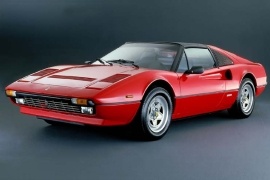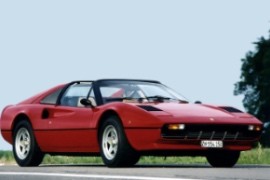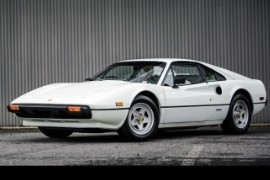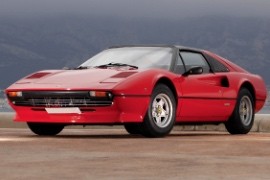FERRARI 308 GTB/GTS Models/Series Timeline, Specifications & Photos
First production year: 1975
Engines: Gasoline
Body style: Coupé (two-door)
Ferrari upgraded the open-top 308 Spyder in 1982 and introduced new technologies to compensate for the power lost due to more recent emission regulations.
With a 255 hp developed from a 2.9-liter engine, the Ferrari 308 was a blast for its times, and many carmakers had to sweat just to keep up with them and, usually, they needed far larger engines than the high-revving V-8 offered by Ferrari. But things got even worse toward the late '70s when the new emission regulations forced the carmakers to lower the power for their cars in order to pass the tests. But the Italian carmaker was already developing a fuel-injection system which, together with the four-valves per cylinder system, allowed the carmaker to get more ponies.
The car sported a very similar exterior from the outside, but with some changes at the front. The carmaker installed a new set of fog lights and a spoiler to increase the downforce. From its sides, it was noticeable that it was not a true roadster or spyder. The GTSi Quatrovalvole sported a removable roof, but the B-pillars, side windows, and rear windscreen remained in place.
On the inside, the most significant improvement was the air-conditioning unit's addition, which Ferrari offered as an option. A redesigned, three-spoke steering wheel became standard for the car. Last but not least, the carmaker added a cloth center for the seats on the options list.
The most significant change by far was the engine, which received new cylinder heads. Its four-valves per cylinder system increased the power from 214 hp up to 240 hp. Even though it was 15 hp shy of the 1975 model and slower by 1.2 seconds to 100 kph (62 mph) from standing start, it was still faster by one second than the 1980 model.
Ferrari finally introduced a four-valves per cylinder version for the 308 range in 1982 and gained back some power lost due to emission controls.
When Ferrari introduced the 308 in 1975, its 2.9-liter engine produced 255 hp, and it was a swift and appreciated car. But things didn't go that well for the Italian carmaker when the new rules regarding emissions were mandatory five years later, and the output had to decrease by 20 percent. The customers were stunned: their brand new models were slower than the previous ones. Ferrari had the solutions, but it took some time to implement them: fuel injection was the first step, and then it added four valves per cylinder. That was better. It was still slower than the 1975 model but faster than the 1980 version.
The car sported a very similar exterior from the outside, but with some changes at the front. The carmaker installed a new set of fog lights and a spoiler to increase the downforce. Since it was a mid-engined car, its front side was light and prone to understeer at higher speeds. Thanks to the new aerodynamic element, there was less air trapped under the vehicle, and thus it decreased the ground effect that lifted the nose.
On the inside, the biggest improvement was the air-conditioning unit's addition, which Ferrari offered as an option. A redesigned, three-spoke steering wheel became standard for the car. Last but not least, the carmaker added a cloth center for the seats on the options list.
The most significant change by far was the engine, which received new cylinder heads. Its four-valves per cylinder system increased the power from 214 hp up to 240 hp. Even though it was 15 hp shy of the 1975 model and slower by 1.2 seconds to 100 kph (62 mph) from standing start, it was still faster by one second than the 1980 model.
The 308 GTSi shared most of its parts with its sibling, the 308 GTBi. It featured the same shape but slightly different details.
Those who watched Magnum P.I. Series in the '80s must have been noticed the Ferrari 308 driven by Tom Selleck. He drove a 308 GTS in the movie, and the Italian carmaker's image went through the roof. All of a sudden, all the good guys wanted to drive a Ferrari.
The 308 GTSi was based on the same platform as the 308 GTBi. That different letter meant that the GTSi was a Spyder (open top) while the GTBi was a Berlinetta (closed coupe). That was the main difference between the two vehicles. Pininfarina designed both vehicles with the same cues and took good care in differentiating them. At the front, the pop-up headlights lowered the drag-coefficient. The carmaker installed a specific exhaust vent for the cars fitted with four valves per cylinder engine behind them. The 308 shape was one of the most recognizable from the Ferrari lineup.
Under the hood, the GTSi featured a 2.9-liter engine with four valves per cylinder. Due to the latest emission regulations, the carmaker had to introduce a fuel-injected system built by Bosch. The result was a cleaner engine, but with plenty of grunts to tear the streets.
In the '80s, Ferrari understood the importance of building an image on the market, and the 308 was the weapon of choice.
Ferrari didn't build the 308 as a race-car with street clothes. Even though the carmaker homologated the vehicle to start in rallies and races, its main job was to keep the Ferrari name on the streets. It was designed as a Grand Turismo Berlinetta and named accordingly. That means it was engineered for long, relaxed drives in a vehicle that could carry some luggage.
Pininfarina designed the car as a three-box coupe and then shaped it as much as it could to make it more aerodynamic. At the front, the pop-up headlights lowered the drag-coefficient. The carmaker installed a specific exhaust vent for the cars fitted with four valves per cylinder engine behind them. The 308 shape was one of the most recognizable shapes from the Ferrari lineup. Its side air-intake for the engine and sloped rear panels were unique on the market.
Inside, the GTBi featured a luxurious cabin with leather everywhere. On the center console, the H-pattern metallic grille for the gear-stick ensured stiff and precise gear changes. The sport bucket seats with high bolstering provided both comfort and stability while cornering.
Under the hood, the GTBi featured a 2.9-liter engine with four valves per cylinder. Due to the latest emission regulations, the carmaker had to introduce a fuel-injected system built by Bosch. The result was a cleaner engine, but with plenty of grunts to tear the streets.
The targa version of the Ferrari 308 GTB received the GTS name and it was one of the cars that made the Italian brand notorious in the U.S. thanks to a movie-series.
You didn't have to grow a mustache and be a detective to drive a Ferrari GTS, but for those who dreamed about themselves to be some kind of heroes just because their bank account showed a six-figure number, it was the right car. Just two years after the GTB was unveiled at the Paris Motor Show, the car received a targa version.
The 308 GTS was one of the best-known Ferrari on the market, and its shape became legendary. The narrow front end with pop-up headlights, the raked windshield, and the side air-intakes made the car unique. Pininfarina designed its shape, and he did, as usual, a great job. From its sides, the thick B-pillars served as side panels and roll-over protection. The Italian designer kept the round taillights as a legacy for the prancing horse brand in the back.
Inside, the carmaker tried to offer a luxurious yet sporty interior. The sport-bucket seats sported leather upholstery and used the same material to cover the door panels. Its black plastic dashboard featured three round air-vents. A removable stereo was offered as an option.
Under the hood, the 308 GTS featured a 2.9-liter V-8 engine that offered 255 hp for the European market and 240 hp for the U.S. market.
Ferrari unveiled the 308 GTB sports car at the Paris Motor Show in 1975, and it was a complete departure from the car’s predecessor, the Dino 246 GTB.
The Italian automaker made the sports car based on some underpinnings from the Dino. Moreover, the vehicle’s design was made by Leonardo Fioravanti at Pininfarina, the same man who penned the 246 GTB. Still, several significant improvements made the 308 GTB a successful go-fast vehicle in Europe and the U.S. Later on, its open-top sibling, the 308 GTS, went on TV shows and gained immense popularity among those who could afford to buy one. The car’s advantages were not limited to its glass-reinforced plastic (GRP) bodywork but also to its interiors and, most importantly, to the powerful engine.
Using a GRP bodywork made the car lighter and, therefore, faster. But the automaker also insisted on making the 308 GTB as aerodynamic as possible but still capable of getting two people onboard easily and transporting them in comfort. At the front, the car featured pop-up headlights with a set of vents behind them that helped cool some radiators. The front bumper sported a black rubber stripe that also housed the turn signals and the parking lights and a grille for the main radiator underneath it.
From its profile, the car showed its graceful look with a low nose and a raked, panoramic windshield. Its short roof was continued at the back by sloped down pillars. Fioravanti penned the vehicle with a set of side air intakes that were sculptured on the door panels and emerged onto the rear quarter panels. This made the car unique not just on the market but also in Ferrari’s history book. Finally, the back of the car looked impressive with its four round taillights and the single exhaust on the side underneath the bumper.
The cabin was comfortable enough for two people, and Ferrari tried its best to create a luxurious environment for its customers. Ferrari covered most areas with leather, including the door cards and the dashboard. In front of the driver, the automaker placed a rectangular-shaped instrument cluster that showed other relevant information about the car’s status besides the speedometer and tachometer. Between the leather-covered sports seats, the car featured a narrow center console with a few switches and buttons for the power windows.
Certainly, the most attractive part of the car was found under its “Vetroresina” (fiberglass) bodywork. The engine mounted in the back was a 2.9-liter V8. It was a clear evolution over the Dino 245 GTB, which featured a 2.0-liter V6. The 308 GTB offered 255 PS (252 hp) for the European version, while U.S. customers got a 240 hp (243 PS) unit due to emission restrictions. Both versions were fed by twin-choke Weber carburetors and sent their power to the rear wheels via a five-speed manual gearbox.





